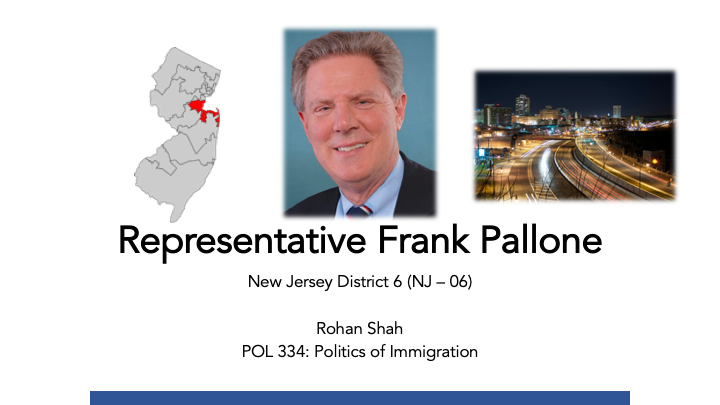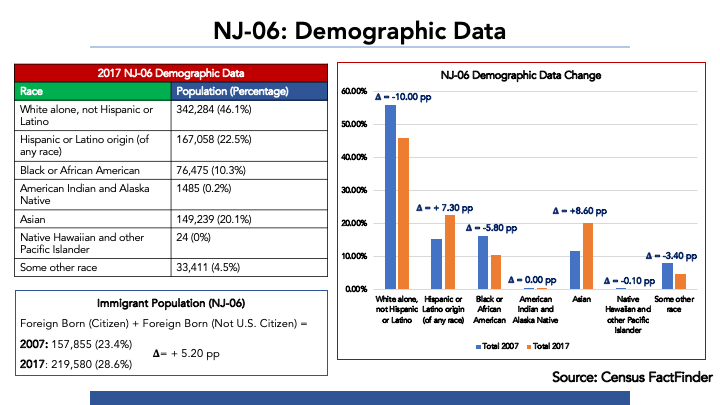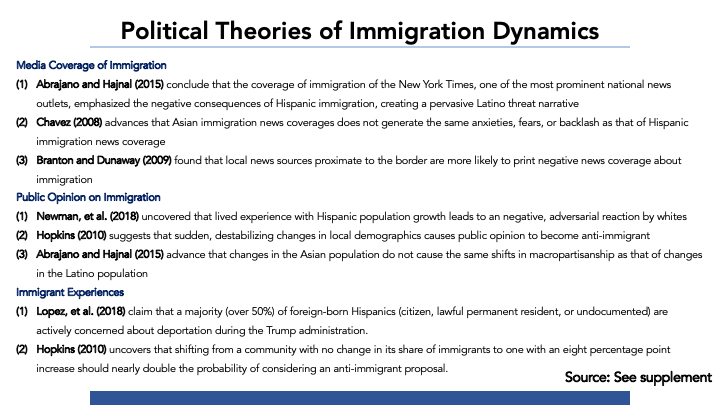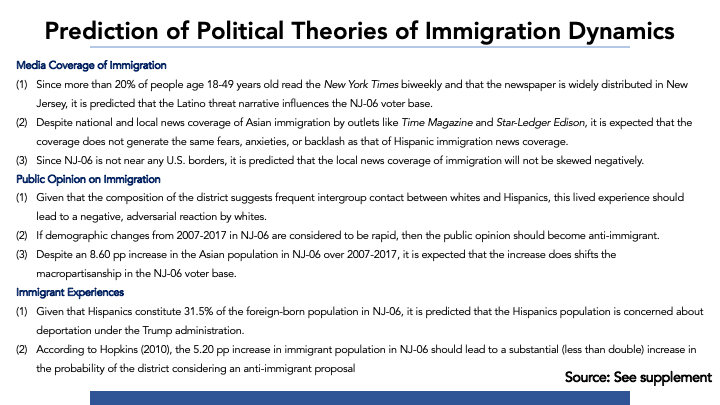
Representative: Frank Pallone
Congressional District: 6th District of New Jersey
Party: Democratic Party

NJ-06: Demographic Data
In comparison to the nation and state, the sixth district of New Jersey is remarkably diverse and has experienced significant demographic changes. First and foremost, the immigrant population—comprising both foreign born naturalized citizens and foreign born permanent residents—currently constitutes 28.6% of the district population which is significantly higher than the national statistic of 14.4% and state statistic of 22.1%. Over the ten year period from 2007 to 2017, the district has experienced a surge in the Asian and Hispanic populations with a 8.60 percentage point increase and 7.30 percentage point increase respectively. Viewed from a macro-perspective, the Asian and Hispanic minorities in fact comprise over 40% of the district population.
Sources
U.S. Census Bureau; American Community Survey, 2007 American Community Survey 1-Year Estimates; Selected Characteristics of the Native and Foreign-Born Populations
U.S. Census Bureau; American Community Survey, 2017 American Community Survey 1-Year Estimates; Selected Characteristics of the Native and Foreign-Born Populations

Political Theories of Immigration Dynamics
Through detailed quantitative and qualitative analysis, political scientists have generated theories to explain the effects of local population characteristics on media coverage, public opinion on immigration, and immigrant experiences. Importantly, Abrajano, Hajnal, and Chavez uncover differential media coverage of Asian immigrants and Hispanic immigrants. Abrajano and Hajnal found that over a thirty year time span, the New York Times has had a negative bent of Hispanic immigration, forming and advancing pervasive Latino threat narrative. According to Chavez, unlike Hispanic immigration news coverage, Asian immigration news coverage does not generate the same anxieties, fears, and backlash. Branton and Dunaway also examined the effect of location and found that proximity to the border was a predicator of a greater negative sentiment. In the same way, Newman uncovered that lived experience with the Hispanic population growth lead to a negative reaction by whites in that area. Abrajano and Hajnal, however, did not find that changes to the Asian population generated the same shifts in the macro-partisanship of the Latino population. At a larger level though, Hopkins found that destabilizing changes in population demographics promoted an anti-immigrant public opinion. Ultimately, the media coverage and public opinion of immigration created potent effects on the immigrant experience. Lopez highlighted that, on a racial level, the Trump administration has driven more Hispanics to be concerned about deportation. On the legislative level, increases in the immigrant population within a locality causes a district to give greater weight to anti-immigrant proposals. Taken as a whole, demographic changes are indicative of neutral or negative immigration sentiments.
Sources:
Abrajano, Marisa, and Zoltan L. Hajnal. White backlash: immigration, race, and American politics. Princeton University Press, 2017.
Chavez, Leo. The Latino threat: Constructing immigrants, citizens, and the nation. Stanford University Press, 2013.
Branton, Regina P., and Johanna Dunaway. “Slanted newspaper coverage of immigration: The importance of economics and geography.” Policy Studies Journal 37.2 (2009): 257-273.
Newman, Benjamin J., Sono Shah, and Loren Collingwood. “Race, place, and building a base: Latino population growth and the nascent trump campaign for president.” Public Opinion Quarterly 82.1 (2018): 122-134.
Hopkins, Daniel J. “Politicized places: Explaining where and when immigrants provoke local opposition.” American political science review 104.1 (2010): 40-60.
Lopez, Mark Hugo, Ana Gonzalez-Barrera, and Jens Manuel Krogstad. “More Latinos Have Serious Concerns About Their Place in America Under Trump.” Pew Research Center, October 25 (2018).

Prediction of Political Theories of Immigration Dynamics
Importantly, there are clear linkages between political theories described and the predicted effects on the sixth district of New Jersey. The prevalence of the New York Times nationally and within New Jersey suggests that the Latino threat narrative is very much present in the minds of voters in the district. In contrast, Asian immigration coverage should likely have limited to no effect on the voter base since that coverage does not stoke the same reactions. Lack of proximity to the U.S. border also means that the local news coverage should not have a negative bend on immigration. The high percentage of Hispanics in the district suggests frequent intergroup contact with whites, possibly leading to a negative, adversarial reaction. Although theory implies that changes in the Asian demographic does not precipitate changes in macro-partisanship, the 8.60 percentage point increase is indeed high and might not be captured by theory. The seemingly rapid change in the demographics of the district, however, do portend a more negative immigrant attitude. On the level of the immigrant, the Hispanic immigrant population likely feels threatened by the Trump administration. The 5.20 percentage point increase in the district immigrant population should also cause a greater consideration of anti-immigrant legislation.

Qualitative Testing of Immigration Dynamics
As demonstrated by the demographic data, the Asian and Hispanic populations experienced the most significant population changes in the district. Given that political theory highlights differential media coverage of these two ethnic groups, the research plan proposed will focus on reactions to media coverage. Through qualitative interviews of Asian, Asian Indian, Hispanic, and White voters in NJ-06, the study will piece together how individual-level, perceived reactions to immigration media coverage align with macro-level data. The research study will not only focus on the framing of these district ethnic communities but also if and how that influences political affiliation. In order to minimize confounding effects, the same question set will be administered to each interview candidate.
Leave a Reply